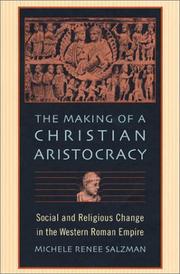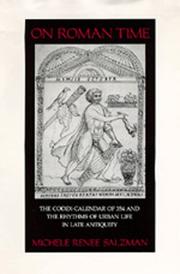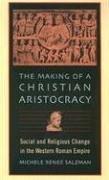| Listing 1 - 10 of 14 | << page >> |
Sort by
|

ISBN: 0674006410 0674016033 0674043049 9780674006416 Year: 2002 Publisher: London: Harvard university press,
Abstract | Keywords | Export | Availability | Bookmark
 Loading...
Loading...Choose an application
- Reference Manager
- EndNote
- RefWorks (Direct export to RefWorks)
What did it take to cause the Roman aristocracy to turn to Christianity, changing centuries-old beliefs and religious traditions? This title takes a fresh look at this much-debated question, looking at the historical evidence in order to try and understand why pagan aristocrats decided to convert to Christianity.
Christian converts --- Aristocracy (Social class) --- Christian sociology --- Church history --- Social change --- Convertis chrétiens --- Aristocratie --- Sociologie religieuse --- Eglise --- Changement social --- Religious life --- History --- Vie religieuse --- Christianisme --- Histoire --- Sociology, Christian --- 27 <37> --- -Aristocracy (Social class) --- -Christian sociology --- -Christian social theory --- Social theory, Christian --- Sociology --- Aristocracy --- Aristocrats --- Upper class --- Nobility --- Christians --- Converts --- Kerkgeschiedenis--Rome. Oud-Italië --- -History --- Social conditions. --- -Kerkgeschiedenis--Rome. Oud-Italië --- -27 <37> --- -Christian converts --- Convertis chrétiens --- Social conditions --- Rome --- Primitive and early church, ca. 30-600 A.D.
Book
ISBN: 9781107019997 9780521858304 9780521858311 1107019990 0521858305 0521858313 9781108703130 1108703135 9781139600507 Year: 2013 Publisher: Cambridge: Cambridge university press,
Abstract | Keywords | Export | Availability | Bookmark
 Loading...
Loading...Choose an application
- Reference Manager
- EndNote
- RefWorks (Direct export to RefWorks)
The Cambridge History of Religion in the Ancient World provides a comprehensive examination of the history of the religions of the ancient Near East and Mediterranean world. The essays in these volumes have a broad reach, covering the ancient Near East and Mediterranean, and extending from the Bronze Age into the late Roman period. Its contributors, acknowledged experts in their fields, incorporate a wide spectrum of textual and material evidence into their analyses of their fields. The regional and historical orientations of the essays will enable readers to see how a religious tradition or movement assumed a distinctive local identity, as well as to understand how each tradition developed within its broader regional context. Supplemented with maps, illustrations, and detailed indexes, these volumes will be an excellent reference tool for scholars and students.
Religions. --- Civilization, Ancient. --- Religions --- Civilisation ancienne --- Godsdiensten. --- Civilisation antique. --- Civilization, Ancient --- 292 --- Comparative religion --- Denominations, Religious --- Religion, Comparative --- Religions, Comparative --- Religious denominations --- World religions --- Civilization --- Gods --- Religion --- Ancient civilization --- Godsdiensten van Grieken en Romeinen. Klassieke mythologie --- Godsdienst. --- Oudheid.

ISBN: 1282355457 0520909100 9786612355455 0585139881 9780520909106 9780585139883 0520065662 9780520065666 Year: 1990 Volume: 17 Publisher: Berkeley: University of California press,
Abstract | Keywords | Export | Availability | Bookmark
 Loading...
Loading...Choose an application
- Reference Manager
- EndNote
- RefWorks (Direct export to RefWorks)
Because they list all the public holidays and pagan festivals of the age, calendars provide unique insights into the culture and everyday life of ancient Rome. The Codex-Calendar of 354 miraculously survived the Fall of Rome. Although it was subsequently lost, the copies made in the Renaissance remain invaluable documents of Roman society and religion in the years between Constantine's conversion and the fall of the Western Empire. In this richly illustrated book, Michele Renee Salzman establishes that the traditions of Roman art and literature were still very much alive in the mid-fourth century. Going beyond this analysis of precedents and genre, Salzman also studies the Calendar of 354 as a reflection of the world that produced and used it. Her work reveals the continuing importance of pagan festivals and cults in the Christian era and highlights the rise of a respectable aristocratic Christianity that combined pagan and Christian practices. Salzman stresses the key role of the Christian emperors and imperial institutions in supporting pagan rituals. Such policies of accommodation and assimilation resulted in a gradual and relatively peaceful transformation of Rome from a pagan to a Christian capital.
Calendar, Roman. --- Rome - Religious life and customs. --- Related Historical Sciences --- History & Archaeology --- Calendars & Chronologies --- Rome --- Social life and customs. --- Religious life and customs. --- Calendar [Roman ] --- Calendrier romain --- Kalender [Romeinse ] --- Calendar, Roman --- -Roman calendar --- Social life and customs --- Religious life and customs --- Vie religieuse --- Moeurs et coutumes --- Rome - Social life and customs. --- HISTORY / Ancient / General. --- Rome - Social life and customs --- Rome - Religious life and customs --- 354. --- ammianus marcellinus. --- ancient rome. --- ancient world. --- antiquity. --- assimilation. --- catholic church. --- christian capital. --- christian emperors. --- christian rome. --- christianity. --- church history. --- codex calendar. --- constantine. --- conversion. --- early church. --- fall of rome. --- festivals. --- history. --- holidays. --- nonfiction. --- pagan cults. --- pagan rome. --- pagan. --- paganism. --- pre julian calendar. --- religion. --- religious freedom. --- religious studies. --- roman art. --- roman calendar. --- roman empire. --- roman literature. --- roman society. --- urban rome. --- western empire. --- Roman calendar --- Rites et cérémonies --- Rites et cérémonies

ISBN: 0674043049 9780674043046 0674016033 9780674016033 9780674006416 0674006410 Year: 2009 Publisher: Cambridge, MA
Abstract | Keywords | Export | Availability | Bookmark
 Loading...
Loading...Choose an application
- Reference Manager
- EndNote
- RefWorks (Direct export to RefWorks)
What did it take to cause the Roman aristocracy to turn to Christianity, changing centuries-old beliefs and religious traditions? This title takes a fresh look at this much-debated question, looking at the historical evidence in order to try and understand why pagan aristocrats decided to convert to Christianity.
Christian converts --- Aristocracy (Social class) --- Christian sociology --- Aristocracy --- Aristocrats --- Upper class --- Nobility --- Christians --- Converts --- Religious life --- History --- Christian converts - Rome --- Aristocracy (Social class) - Religious life - Rome --- Sociology, Christian - History - Early church, ca. 30-600 --- Sociology, Christian
Book
ISBN: 1316468585 1316468836 1316469832 1316469085 1316470334 1316274985 1107110300 1107527031 9781107527034 9781107110304 1316467082 Year: 2015 Publisher: New York: Cambridge university press,
Abstract | Keywords | Export | Availability | Bookmark
 Loading...
Loading...Choose an application
- Reference Manager
- EndNote
- RefWorks (Direct export to RefWorks)
This book sheds new light on the religious and consequently social changes taking place in late antique Rome. The essays in this volume argue that the once-dominant notion of pagan-Christian religious conflict cannot fully explain the texts and artifacts, as well as the social, religious, and political realities of late antique Rome. Together, the essays demonstrate that the fourth-century city was a more fluid, vibrant, and complex place than was previously thought. Competition between diverse groups in Roman society - be it pagans with Christians, Christians with Christians, or pagans with pagans - did create tensions and hostility, but it also allowed for coexistence and reduced the likelihood of overt violent, physical conflict. Competition and coexistence, along with conflict, emerge as still central paradigms for those who seek to understand the transformations of Rome from the age of Constantine through the early fifth century.
Rome --- Religion. --- Rome - Religion
Book
ISBN: 1316275922 1009064355 1009064177 1107111420 9781107111424 Year: 2021 Publisher: Cambridge : Cambridge University Press,
Abstract | Keywords | Export | Availability | Bookmark
 Loading...
Loading...Choose an application
- Reference Manager
- EndNote
- RefWorks (Direct export to RefWorks)
Over the course of the fourth through seventh centuries, Rome witnessed a succession of five significant political and military crises, including the Sack of Rome, the Vandal occupation, and the demise of the Senate. Historians have traditionally considered these crises as defining events, and thus critical to our understanding of the 'decline and fall of Rome.' In this volume, Michele Renee Salzman offers a fresh interpretation of the tumultuous events that occurred in Rome during Late Antiquity. Focusing on the resilience of successive generations of Roman men and women and their ability to reconstitute their city and society, Salzman demonstrates the central role that senatorial aristocracy played, and the limited influence of the papacy during this period. Her provocative study provides a new explanation for the longevity of Rome and its ability, not merely to survive, but even to thrive over the last three centuries of the Western Roman Empire.
Rome --- Rome (Italy) --- History --- Politics and government. --- Politics and government --- Europe --- Rome - History - Empire, 284-476 --- Rome (Italy) - History - 476-1420 --- Rome - History - Germanic Invasions, 3rd-6th centuries --- Rome - Politics and government - 284-476 --- Rome (Italy) - Politics and government
Multi
ISBN: 9781107111424 9781316275924 9781107529090 1107111420 Year: 2021 Publisher: Cambridge: Cambridge university press,
Abstract | Keywords | Export | Availability | Bookmark
 Loading...
Loading...Choose an application
- Reference Manager
- EndNote
- RefWorks (Direct export to RefWorks)
Over the course of the fourth through seventh centuries, Rome witnessed a succession of five significant political and military crises, including the Sack of Rome, the Vandal occupation, and the demise of the Senate. Historians have traditionally considered these crises as defining events, and thus critical to our understanding of the 'decline and fall of Rome.' In this volume, Michele Renee Salzman offers a fresh interpretation of the tumultuous events that occurred in Rome during Late Antiquity. Focusing on the resilience of successive generations of Roman men and women and their ability to reconstitute their city and society, Salzman demonstrates the central role that senatorial aristocracy played, and the limited influence of the papacy during this period. Her provocative study provides a new explanation for the longevity of Rome and its ability, not merely to survive, but even to thrive over the last three centuries of the Western Roman Empire
Politics and government. --- Italy --- Rome (Empire). --- Rome (Italy) --- Rome --- History --- Politics and government --- Roman history --- anno 300-399 --- anno 400-499 --- Rome - History - Empire, 284-476 --- Rome (Italy) - History - 476-1420 --- Rome - History - Germanic Invasions, 3rd-6th centuries --- Rome - Politics and government - 284-476 --- Rome (Italy) - Politics and government
Book
Year: 1989 Publisher: Wiesbaden Steiner
Abstract | Keywords | Export | Availability | Bookmark
 Loading...
Loading...Choose an application
- Reference Manager
- EndNote
- RefWorks (Direct export to RefWorks)
Book
Year: 1993 Publisher: Wiesbaden Steiner
Abstract | Keywords | Export | Availability | Bookmark
 Loading...
Loading...Choose an application
- Reference Manager
- EndNote
- RefWorks (Direct export to RefWorks)
Digital
ISBN: 9780674043046 Year: 2009 Publisher: Cambridge, Mass. Harvard University Press
Abstract | Keywords | Export | Availability | Bookmark
 Loading...
Loading...Choose an application
- Reference Manager
- EndNote
- RefWorks (Direct export to RefWorks)
| Listing 1 - 10 of 14 | << page >> |
Sort by
|

 Search
Search Feedback
Feedback About UniCat
About UniCat  Help
Help News
News